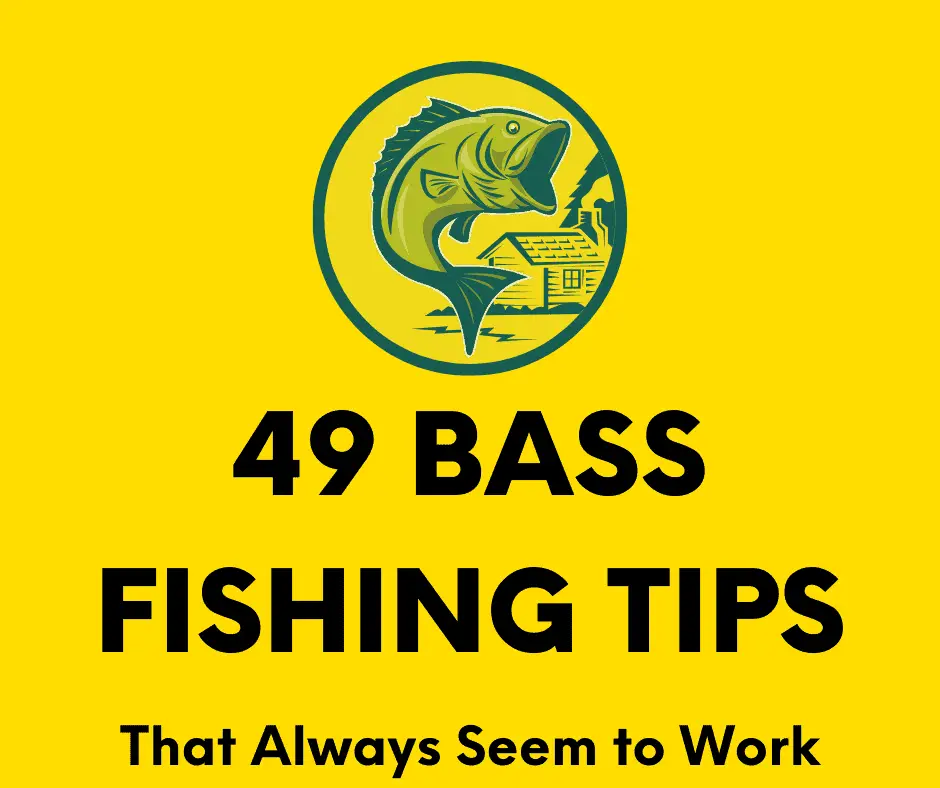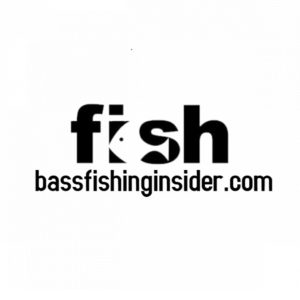
Ever feel like you’re doing everything right—but still not catching bass? You’re not alone. The difference often comes down to small, overlooked details. These 49 tips aren’t just filler—they’re real, proven tactics that turn slow days into personal bests. Whether you’re just starting out or you’ve been at it for years, there’s something here that will help you catch more bass.
Check out the list below for 49 great bass fishing tips that always seem to work.
1. Match the Hatch to Choose the Right Lure
Matching the hatch is, perhaps, one of the most important things you can do to make lure choices effectively. The concept is pretty straightforward.
Determine what the prevailing baitfish is before deciding on your lure. For example, if you’ve identified shad as the target prey for your fishery, you should choose a lure with shad-like colors and is similar in size to the shad in your lake.
2. Do This To Catch Summer Bass
Shallow water bass seek cover for specific reasons. If you’re fishing shallow, look for shade, that’s where the bass will be. Docks, overhanging trees, and lily pads are excellent sources of shade.
Most bass head deep when water temperatures rise in search of more stable water with higher oxygen content. Find offshore structure like underwater points, humps, and channel swings to locate summertime bass.
3. Use These Tips for Cold Front Bass Fishing
Cold fronts have a profound effect on bass fishing. Bass are generally on fire and eating aggressively just before a cold front. However, once the cold front hits and you begin to feel the first hint of changing air temps, often, the bite will shut down. It’s typical to see bright, bluebird days after a cold front with a corresponding slow bite.
Get on the water to catch loads of bass in pre-cold front conditions. Throw anything but focus on moving baits. In post-cold front conditions, downsize your lure and slow down. Slowing down with a Senko rigged Texas or wacky style can turn a tough bite into steady hookups, especially when bass are cruising the shallows.
4. Choose the Correct Bait Color to Get More Bites
Bass aren’t as sensitive to color choices as lure companies would have you believe, so don’t overstress about whether you should go with the pumpkin seed, black and blue, peppermint flake versus the motor oil, mean green, polka dot version of the same worm (note sarcasm).
Bass understand contrast mostly, so keep it simple. Choose darker colors like black and blue when light penetration is low (overcast, at night, darker water, etc.). Opt for more natural colors like green pumpkin when light penetration is high (brighter sun, clear water, etc.)
5. Don’t Underestimate the Value of Sneaky Feet
Bass have incredibly sensitive hearing, so be aware of your noise levels. Large bass, particularly, will become extra skittish when they hear loud noises. Although bass may hear minimal levels of talking and chit-chat, that’s not the principal concern.
The more significant issue is any noise that has a chance to reverberate underwater. Things that make a “clunking” sound in the boat are the biggest issue because those sounds travel far underwater. Be extra careful with things like closing boat compartment lids, using the trolling motor too much, trimming your big motor up and down, dropping things onto the boat (like phones, weights, drinks, etc.), or even inadvertently stomping in the boat.
Being a “lighter” presence will go a long way and contribute significantly to your bass fishing success.
6. Set the Clock and Be the Early Bird
The early bird gets the worm, and so do bass. Early mornings can be one of the most productive times of the day to fish. Bass generally eat less at night and are ready for a meal in the morning. Additionally, bass’ eyes are stronger than their prey, meaning that they can take advantage of low light settings in the morning to come out of their hiding spots to cover more territory and feed more. So get up and get out early to take advantage of the morning bite for bass fishing.
7. Adjust Like This for Low Light Conditions
As mentioned above, light penetration affects bass in big ways. When the sun is high and bright, look for bass to tuck into the thickest cover they can find, like matted vegetation, docks, and lily pads. During low-light settings like mornings, dusk, and overcast conditions, bass will come out of hiding to feed.
Consider the amount of sunlight when deciding where and with what techniques to fish for bass.
8. Choosing the Right Rod and Reel is Critical. Here’s How.
Most bass fishing is done with either a spinning reel or a baitcaster. Baitcasters are more popular for bass fishing for various reasons, but spinning reels certainly have their place. For a better understanding of when to use each type of reel, check out these two Bass Fishing Insider articles:
- What Lures Do You Use with a Baitcaster
- Are Spinning Reels Good for Bass Fishing? Pro Secrets
- What is the Best Spinning Reel for Bass Fishing?
- Using Baitcasters for Bass Fishing
- Best Casting Rods for Bass Fishing with a Baitcaster
9. Let Nature Help You Find the Bass: Birds
Bass feed on bait. Find the bait, and you’ll find the bass, but just how do you find bait?
One way to find bait is by observing nature in action. For example, if you see a group of birds repeatedly diving into the water, that can only mean one thing: they’re feeding on baitfish.
Likewise, herons wading in the water are there for a reason. They’ve likely found a bunch of shad or other baitfish they’re using as a food source.
Pay close attention to bird behavior to locate bass.
10. Downsize When the Bite Gets Tough
When fishing gets tough, consider downsizing. For example, while fishing in Florida for bass, I was throwing my standard Zoom speed worm, but the bite was off due to a cold front.
I only had one size with me, so I started biting about an inch off each worm’s head before threading it onto the hook.
I started getting bites almost immediately after the change. The smaller profile seemed to be just what was needed to spark the bass’ interest.
Next time the bite gets tough, try downsizing to a smaller lure or bait option.
11. To Find Spring and Early Summer Bass, You Must Understand the Spawn
Bass movement in the spring and early summer periods is directly related to which cycle of the spawn that fish are in. Therefore, before trying to find bass, FIRST determine whether they are pre-spawn, spawn, or post-spawn. These periods are related to water temperature and moon phases, among other things. See 12, 13, and 14 below for location tips for the specific stages of the spawn.
12. How to Find Pre-spawn Bass
Pre-spawn bass are found in “staging” areas, preparing to move up into shallower bedding spots. In the pre-spawn, look for transition spots like points, main lake ditches, and other structures that sit close to an area (but not in an area) where bass will eventually spawn.
13. Tips for Locating Bass During the Spawn
Bass look for areas with certain qualities to find the best spot to make beds. They generally spawn in shallower, wind-protected areas that include a hard bottom. Grass flats, canals, creeks, and other shallow-water hangouts, especially banks and shoreline areas, are great places to start searching for spawning bass.
14. Where to Locate Post Spawn Bass
Post-spawn bass are notoriously finicky and difficult to find and catch. Many post-spawn bass will hang around beds to guard fry or remain until water temps rise, which motivates them to make a move to deeper water.
Other post-spawn bass begin to move out very shortly after bedding. You can find those fish in areas similar to the pre-spawn hangouts mentioned above (staging areas close to bedding areas).
15. Use the Shad Spawn to Your Advantage
Fishing for bass during the shad spawn can be extremely rewarding, but there are some tips and tricks that will greatly increase your catch rate and some pitfalls to avoid. For a great article about fishing the shad spawn for bass, check out Bass Fishing Insider’s article, How Do You Catch Bass During the Shad Spawn?
16. Put technology to Use, or You’re Missing Out.
I’ve been around bass fishing for quite a long time and have seen it evolve and progress through multiple significant technological advances. Among the latest and greatest are:
- Shallow water anchors that you can deploy with the push of a button. Power Pole makes one of the most revolutionary products on the market. Check it out on Amazon.
- Trolling motors that will hold you in place even in the strongest wind.
- Fishfinders allow you to see all of the way around your boat. New graphs can even show live, animated fish locations on your electronics.
Needless to say, there’s a price to pay for these kinds of capabilities, but these resources and tools can be incredible game-changers for any level of fishing.
17. Choosing the Right Weight Can Make or Break You
Hard plastics, spinnerbaits, jigs, and other lures are almost always already weighted. However, many soft plastics can be fished weightless or weighted. Choose the wrong weight, and your fall rate will be so fast that it may fly right past waiting fish. Choose one that’s too light, and it may never reach them. Additionally, choosing the right STYLE of weight is critical to your success.
For a great read on bass fishing weight, check out What Weight Should I Use for Bass Fishing?, a Bass Fishing Insider article.
18. Learn to Be Pitch Perfect
Making accurate casts with a soft landing is essential to fish for bass without spooking them. Learn to pitch as an alternative to using a full casting motion.
19. Move Like a Ninja for Bank Fishing
Bass are extremely sensitive creatures and can detect movement in and out of the water through their keen vision. While bank fishing, do everything possible to stay as far away from your intended target as possible. Also, move into the sun as you walk the bank when possible so that your shadow trails behind you.
Check out this article full of secret tricks on fishing from the bank for bass.
20. Fish Lily Pads Like This
Bass can almost always be found in lily pads. When the pad cover is dense, try punching through them with a half-ounce tungsten-weighted creature bait. Let it slide through the pad cover and glide to the bottom. Once there, gently move the bait up and down off of the bottom to elicit a strike.
One of my favorite creature baits is the Strike King Rage Bug.
21. What’s Up With Docks? Bass Love ’em.
Docks almost always hold fish. Fish the outside edges of docs with a drop shot for a slower presentation. Try a chatterbait for a moving bait alternative.
Learn to skip an unweighted wacky rig or Senko under docks to tempt hard-to-reach bass. Try skipping jigs under docks to work on bigger bass for a bulkier option.
Check out tip 39 below for more information on how to use skipping to fish docks.
22. Find the Grass = Find the Bass.
If you can find submerged grass, you’ll almost always find bass. I’ve had my best luck when there is at least two to three feet of water between the top of the grass and the surface of the water.
23. Slow Down When Things Get Tough
Many conditions can cause the bass to become tight-lipped. For example, extreme cold and hot weather can make bass a little finicky.
When times get tough, slow down with your lure and bait presentations. For example, take longer between topwater and jerkbait twitches, slow roll a spinnerbait, and work your soft plastics at a snail’s pace.
24. Adding Scent for Bass Makes Sense
Bass can detect scent and play a major role in your bass fishing success. To better understand the use of scent for bass fishing, read this in-depth article from Bass Fishing Insider, Do Bass Smell Bait? (Scent Secrets to Catch More Fish).
25. Don’t Set the Hook with These Lures
Although setting the hook is the popular mantra among bass anglers, it’s NOT always the right way to hook a bass.
Setting the hook with a sharp and quick rod snap makes sense with many soft plastics but will cause you to lose fish on many other lures. For treble hook baits and many finesses lures like drop shots or soft plastics, you’ll fare better using a more gradual, less violent sweeping motion instead.
26. Stop Losing Fish by Setting the Drag Properly
Set the drag too tight, and you risk a fish breaking your line during a fight. On the other hand, setting your drag too loose may hinder your hookup ratio or let fish roam too much during the fight.
Find a happy medium by gently pulling on your line with your hand. You should be able to barely pull the line out without overexerting. Although there are certainly more nuances with setting your drag, this will give you a good starting point for understanding where your drag should be set.
27. Head for Cover When It’s Hot, and the Sun is High
When the sun is at or near its highest point, and the weather is hot, bass usually head for the thickest cover they can find. Therefore, look for bass in matted vegetation, docks, or any other heavy cover that they would likely head to so they can retreat and “duck away” from the sun’s rays.
28. Get Rid of the Bobber with Live Bait. Free Line.
When fishing with live bait (shiners, minnows, etc.), most people fish with a bobber to easily see when they have a bite.
Try “free-lining” your bait occasionally by removing any floats or bobbers. By free-lining, you’ll give the bait a chance to move more naturally, which may result in more bites.
29. Learn to Read a Contour Map
To get an idea of where to start your fishing day, especially for offshore bass, jump on Navioincs.com or use your fishfinder’s map to find underwater points, holes, humps, and other structure. You can find structure without fish, but you won’t find fish without structure.
30. Run from Pressure
Avoid the pressure placed on fish caused by pleasure boating and other anglers. Try these three pressure-relieving tips:
- Choose locations that most people won’t fish.
- Cast where others won’t or can’t cast.
- Fish at times when most won’t.
31. Change Up Your Moving Bait Retrieval
Most people reel in moving baits at a steady pace. However, when fishing with lures like crankbaits, spinnerbaits, chatterbaits, and others, change it up by varying the speed of your retrieval during your cast. Try “killing it” at various times throughout the cast or speeding it up intermittently. Bass react well to erratic behaviors in your lure.
32. How to Go Big for Big Bass
Big bass have been around a long time and have seen a lot of baits. Sometimes, they need to be tempted by something big enough to motivate them to eat. Try going with a bait bigger than usual, like a ten or 12-inch worm or an extra-large swimbait to catch bigger fish.
When you need to tempt a true giant, go big or go home—this 10-inch ribbon tail worm thumps hard, pushes water, and gets noticed by the kind of bass that eat once and make it count.
33. Add a Trailer Hook if You’re Missing Bass
Add a trailer hook if bass are short-striking for single hook presentations like spinnerbaits and buzzbaits. Your hookup ratio will increase.
34. Change Out Factory Treble Hooks
Many factory treble hooks, while sufficient, don’t give you that extra edge you need to hook and catch bigger bass. Upgrading the size of your treble hooks will increase your hookup ratio.
35. Wear Gloves When Applying Sunscreen or Bugspray
Bass can detect scent. When applying sunscreen or bug spray, use a pair of latex gloves so you don’t cross-contaminate your baits and lures with a scent that turns bass off.
36. Trim Down Baits To Battle Short Striking
To combat short striking by bass, try trimming the end of your bait off with a sharp pair of scissors. Shorten soft plastics, spinnerbait skirts, frog legs, and trailers to increase hookup ratios.
37. Color Your Line.
If you’re fishing with a braided line that is not black or green, try using a black marker to color the first couple of feet of your line, especially when fishing in heavy vegetation, so that your bait enters incognito as much as possible.
38. Go Bold for Big Wind
Try increasing the “presence” of your bait or lure when the wind picks up. For example, throw spinnerbaits with more or bigger blades or upgrade to a louder chatterbait when the wind really picks up.
39. Skip Your Way to More Bass
Reaching bass tucked back in tight cover is not easy. Bass hide under docks, overhanging trees, bushes, and other obstacles, especially during high sun or hot days. Reaching those fish can be extremely tough. Learn to skip baits and lures to reach bass in these tough-to-reach spots.
40. Use White Soft Plastics When Sight Fishing for Bass
I go with soft white plastics (tubes, creature baits, etc.) when I’m sight fishing for bass on beds to easily see when the bass has taken my bait. By using white, I get an instant notification when it’s time to set the hook.
Read The 12 Best Sight Fishing Baits for Bass for more details.
41. Fish Shell Bars with Carolina Rigs
Bass love to set up and feed on shell bars. Carolina rigs separate your soft plastic from the weight allowing it to suspend in the water column. This highly effective tactic pays off big for bass holding to hard bottom spots like shell bars.
42. Fish a Fluke for Shallow Water Bass
Flukes are one of the most versatile bass fishing baits on the market. They are great around cover because they are weedless and virtually snagless. Fish them faster in low light settings or slow down for brighter sun. They are excellent imitations of baitfish that bass can’t resist!
One of the most versatile soft plastics out there, the Zoom Fluke is a go-to bait when bass are feeding shallow, chasing bait, or just being picky.
43. Stop Horsing and Maintain Pressure
For lures with more than one hook, “horsing” a fish in is generally not the best idea. Horsing a fish is akin to using strong-arm methods to reel fish in quickly. Instead, try keeping steady pressure on the fish so they can’t shake or jump while reeling them in. Take your time and tire out your catch. Once tired, you’ll be able to finish the job more easily.
44. Use Fluorocarbon for Bass in Clear Water
When fishing clear water, you need to do anything possible to stay stealthy. I’ve noticed a significant difference in the number of bites I get on braid or mono versus fluoro in clear water. Clear water fish are notoriously picky eaters, so use fluoro line to help combat the suspicious nature of bass.
45. Learn the Palomar Knot
The Palomar knot is probably one of the easiest knots to tie, yet strong and effective.
46. Wait to Set the Hook With Soft Plastics
Many new anglers jump the gun on hooksets with soft plastics. The truth is that there is no rush. Most bass inhale bait and keep it in their mouth for quite some time before rejecting it.
If you set the hook too early, bass may not have committed to it entirely yet, which could adversely affect your hookup ratio. Instead, try lifting your rod slightly until you barely feel the weight of the fish before setting the hook.
47. Try a Frog for Thick Cover Bass
Frog fishing can be one of the most explosive and exciting ways to catch bass. When you’re facing thick cover but know that bass are waiting underneath, tie on a frog on braid to work heavy vegetation, and you’ll see excellent results.
Few topwater baits get as many violent blowups as the BOOYAH Pad Crasher—it walks, skips, and slips through cover like it was built for chaos.
48. Fish Isolated or Different Cover for Bass
Look for opportunities to fish isolated cover or things different from the rest of the surroundings. Here are a few examples:
- A stump in the middle of a lily pad field.
- A point in a long line of reeds.
- A small clump of matted vegetation that stands out from a larger mass of grass.
The point is to look for things that stand out — that’s where to start your fishing.
49. FISH HOW YOU WANT TO FISH
This one deserves, arguably, the most attention of all. Many anglers, including myself, try to fit into the mold of how they think they should be fishing. Although some credence should be given to seasonal patterns, current weather, and other relevant concerns, I recommend fishing in areas and using techniques that you are comfortable with and enjoy.
If you like throwing a chatterbait, look for offshore grass with some wind. If you like fishing docks, find the area of the lake with the most docks and head there. If you’re a deepwater structure guy, study your maps and get on your electronics.
The bottom line is that you’ll fish better if you do things you enjoy and have confidence in.
❓ Beginners: Frequently Asked Questions
What’s the single most important bass fishing tip for beginners?
Start with the right lure for the conditions. You don’t need a tackle box full of options—just a few basics that work in your local waters, like a soft plastic worm, spinnerbait, and topwater popper.
What’s the best way to get started with bass fishing?
Start simple: use a spinning combo, some soft plastics like Senkos or creature baits, and fish around visible cover. Focus on casting accuracy, learning how to feel bites, and experimenting with retrieve speeds.
The Bass Line. Final Word.
The more you enjoy your fishing experience, the more success you’ll likely have. So combine your favorite kinds of areas with techniques you like to fish, get to the closest fishery, and FISH HOW YOU WANT TO FISH!
Affiliate Disclosure:
Some of the links in this post may be affiliate links. If you make a purchase through them, we may earn a small commission at no extra cost to you.




